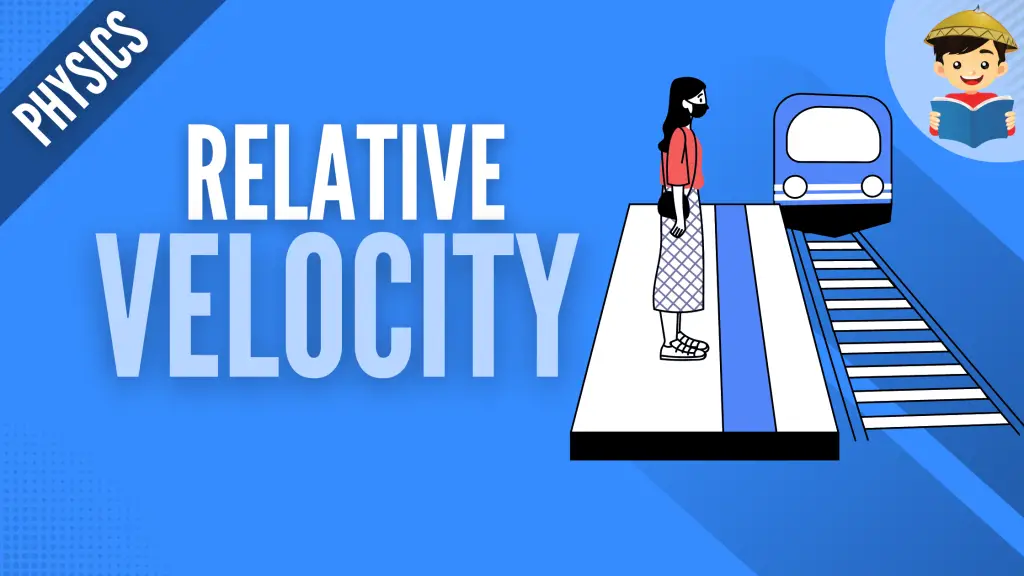Relative Velocity

Have you ever noticed how the trees, structures, and other things seem to be going backward when you look outside a moving bus? Are they really moving backward?
Of course, you know they do not because they are stationary on the ground while the bus that you are riding moves.
How about the people you are with inside the bus?
They appear to be at rest despite moving because you and the other passengers are in the same place (bus). That means there is no relative velocity between you and the passengers.
On the other hand, the trees are stationary when you are moving, which means they move at a relative velocity with respect to the people inside the bus.
But what is relative velocity?
The relative velocity is the velocity of an object (observer B) in the rest frame of another object (observer A). To understand this concept easier, let us first consider the relative velocity of objects moving along a straight line.
Click below to go to the main reviewers:
Table of Contents
- Relative Velocity in One Dimension
- Relative Velocity in Two or Three Dimensions
- Download Article in PDF Format
- Test Yourself!
Relative Velocity in One Dimension

Suppose an LRT train moves with a velocity of 5 m/s. A passenger walks along the aisle of the train with a velocity of 0.5 m/s.
What do you think is this passenger’s velocity?
Sitting on the train, you’ll say that this passenger’s velocity is just 0.5 m/s. However, if you observe outside the train or on another train going in the opposite direction, you will give another answer.
This question is simple, yet there is no concrete answer unless we specify which observer we mean and speak of the velocity relative to a particular observer. This is what we call a frame of reference.
Let’s say you want to find the passenger’s velocity relative to the observer (at rest with respect to the ground) outside the LRT train. To make this simple, we will use A to represent the observer’s frame of reference and B to represent the moving train’s frame of reference.
To solve for velocity, we are going to use the formula
VP/A-X = VP/B-X + VB/A-X
Where VP/A-X is the velocity of P with respect to A; VP/B-X is the velocity of P with respect to B, and VB/A-X is the velocity of B with respect to A.
In this problem, we want to find the passenger’s velocity VP/A-X with respect to the observer. We know that VP/B-X = 0.5 m/s and VB/A-X = 5 m/s. Performing the calculation, we will get,
VP/A-X = VP/B-X + VB/A-X
VP/A-X = 0.5 m/s + 5 m/s
VP/A-X = 5.5 m/s
In this example, both velocities move in the same direction, which we take as positive. In case the passenger walks to the left relative to the train, VP/B-X = – 0.5 m/s. This makes the passenger’s velocity VP/A-X with respect to the observer equal to 4.5 m/s.
In case the passenger looks out the window, the observer appears to be moving backward. In this instance, the observer’s velocity relative to the passenger is VA/P-X which is just the negative of the passenger’s velocity relative to the observer, VP/A-X.
In general, if A and B are any two points or frames of reference, VA/B-X = – VB/A-X
Sample Problems:
Suppose you are on a bus moving at 35 kph. Your sister sits next to you, and another passenger walks on the aisle at 0.01 kph.
- What is your relative velocity with respect to the Earth?
- What is your relative velocity with respect to your sister?
- What is the passenger’s relative velocity with respect to the Earth?
- What is the passenger’s relative velocity with respect to you and your sister?
Solution:
- Since you are in a bus moving at 35 kph, your relative velocity with respect to the Earth is 35 kph.
- Since you are both inside the bus and stationary, your relative velocity with respect to her is 0.
- Since the passenger is walking on the aisle at 0.01 kph and the bus is moving at 35 kph, the passenger’s relative velocity with respect to the Earth is 35.001 kph.
- Since you and your sister are sitting on the bus and are stationary, the passenger’s relative velocity with respect to you and your sister is 0.01 kph.
Relative Velocity in Two or Three Dimensions
We often experience instances when one or more objects travel with respect to another observer in a frame that is non-stationary.
A perfect example is a ship crossing a river that flows at some rate or an airplane encountering wind during its motion.
In all these cases, the effect that the medium has on the object must be considered to explain the complete motion of the object.
We measure the relative velocity of the object when doing so, taking into account the particle velocity and the relative velocity.
Sample Problem:
An airplane travels through the air at 280 kph in the North direction. If there is a wind traveling in the East direction at a rate of 45 kph, find the airplane’s velocity relative to the Earth.
Solution:
In this problem, there are velocities in two dimensions involved: North and East. To solve this problem, we will apply the concept of vectors.
We are given the velocity of the airplane relative to air VP/A = 280 kph and air velocity relative to the Earth VA/E = 45 kph. We are looking for the airplane’s velocity relative to the Earth, VP/E. We know that
VP/E = VP/A + VA/E
Note that these three relative velocities form a right triangle; therefore, we will use vector addition to solve this problem.

So to answer the question, the airplane’s velocity relative to the Earth is 283.6 kph at 9° East of North.
Next topic: Laws of Motion
Previous topic: Kinematics
Return to the main article: The Ultimate Physics Reviewer
Download Article in PDF Format
Test Yourself!
1. Practice Questions [PDF Download]
2. Answer Key [PDF Download]
Written by Mary Joy Montenegro
Mary Joy Montenegro
Mary Joy Montenegro is a licensed professional teacher who obtained her Master’s Degree in Teaching Physics at De La Salle University under the Department of Science and Technology Scholarship. Aside from teaching, she also loves traveling and meeting other people.
Copyright Notice
All materials contained on this site are protected by the Republic of the Philippines copyright law and may not be reproduced, distributed, transmitted, displayed, published, or broadcast without the prior written permission of filipiknow.net or in the case of third party materials, the owner of that content. You may not alter or remove any trademark, copyright, or other notice from copies of the content. Be warned that we have already reported and helped terminate several websites and YouTube channels for blatantly stealing our content. If you wish to use filipiknow.net content for commercial purposes, such as for content syndication, etc., please contact us at legal(at)filipiknow(dot)net
